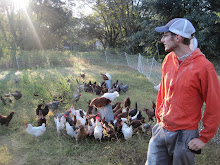
Raised, mulched beds. How do you do it? After planting the beds, we mixed compost (for organic matter) and chicken bedding (a composted mixture of manure and straw--for nitrogen) into the top 4 inches or so of soil, then laid out our drip irrigation lines. You could also lay out your lines first and then plant. Gardening is a flexible science, not to be approached too rigidly. The most important thing is that you have good intentions.

A main header line runs the entire width of the garden, and individual drip lines "t" out over the beds. You can custom fit as many drip lines as you like in your beds depending on the placement of your rows. A system like this is relatively inexpensive and will last about 3 to 5 seasons. It's also 75% more efficient than overhead watering because the water comes out slowly where it's needed in the soil/roots and not the leaves. There's definitely an initial time investment to get it set up, but overall you'll save yourself lots of labor by eliminating any need for hand watering.

Once we installed the drip, we mulched heavily--about 4 inches deep--with wheat straw to conserve moisture in the beds, shade out future weeds, and deter any erosion you may have in heavy rains. As an added plus, the straw adds organic matter to the soil as it decomposes.

Yes, it's hard work, but it does a body good. There's an upfront investment to build the beds properly and get them set up, but I look so satisfied in this picture because the advantage of this style of gardening is that you won't have to do those things again--no future tilling necessary, and with the mulch so thick, weeds are easily pulled out by hand. Under the straw your soil composition continually improves and there's less need for compost or other amendments every year. If you lack a tractor (me, I've got no interest in them) or detest walking behind a smelly rototiller, this is a great way to grow.
So now all we have to do is get the other 7,750 square feet planted--and soon!
--Arianne


No comments:
Post a Comment